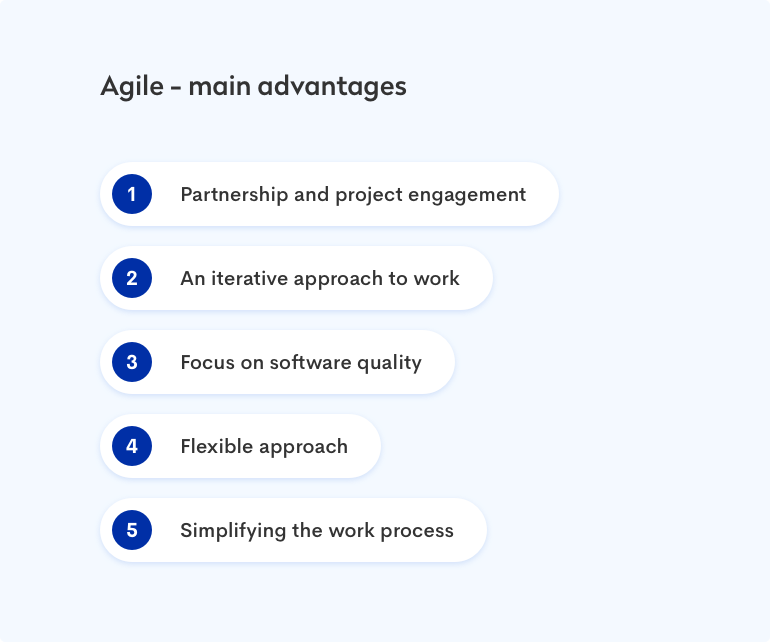Agile Methodology in a Nutshell: How to Manage an IT Project Effectively
The popularity of the Agile methodology in software development has grown rapidly in recent years and has been eagerly applied for two decades. No wonder, because applying the principles and values of the Agile Manifesto sets a solid foundation for delivering high-quality products, taking into account the needs of the customer and the defined project framework.
There are many IT project management methodologies in use today, but Agile methodologies are most preferred. One of the main reasons is that it involves each party in all stages of the project, which greatly speeds up the delivery of valuable software.
Table of Contents
What is Agile?
The principles of Agile were created as an answer to one of the main problems that many companies face, which is focusing on detailed planning and documenting every single stage of the project, even far into the future. Such an approach ignores the aspect of changing requirements and the use of information already collected during the project. Agile focuses on delivering value to customers by responding to a dynamically changing environment.
The Agile methodology in software development began with the Agile Manifesto, created in 2001 by a group of 17 software engineers who had a different view of project delivery. The Agile approach was developed from methodologies and frameworks that already existed. Selecting the practices that yielded the best results and the experience they gathered helped to shape a common approach.
Principles behind the Agile Manifesto
According to the manifesto, the main element of Agile software development, and what we value most in our own performance, is putting more focus on:
- Individuals and interactions than processes and tools
- Working software than detailed documentation
- Client collaboration than contract negotiation
- Responding to change than following a plan.
This doesn’t mean that the elements listed on the right aren’t important in our work, or in the software development process. A collaborative approach doesn’t exclude the possibility of negotiating contracts, and responding to change doesn’t mean that we act completely spontaneously. A roadmap, a structured workflow, and documentation are all still important.
In addition to the four core values, the Agile Manifesto sets out 12 principles that can be considered extensions of these values. They emphasize the importance of customer satisfaction, reacting to evolving requirements, a collaboration between all parties involved in the project, and staying focused on quality.
Working with Agile methodology – why use it in software development?
Agile principles have helped us find the best possible approach to IT project development so that we can achieve our goals effectively. Top IT Services Companies used to work in Agile approach. Here are the most common Agile methodology advantages we rely on in our daily process.
- Partnership and project engagement
Above all, we focus on partnership. From the beginning, everyone is involved in the project – both the client and the people working on it. We strive to deliver a product in line with expectations, which is why we focus on the client’s role in the project and listen and react on an ongoing basis. We see how effective it is – regular communication, workshops, the client’s presence at daily meetings, and a well-designed onboarding process are the keys to client satisfaction.
- Iterative approach to work
Dividing a project into sprints enables us to start the job without the client having to prepare detailed specifications. Working together on details for 2-3 consecutive sprints allows us to act and clarify subsequent issues on the fly.
The client doesn’t need to know all the details surrounding their project right away (e.g., regarding the payment provider they’re going to use), so our role is to assist and advise. The client presents us with an application idea, and we help them choose the best solution by suggesting what will bring the best results and what won’t.
- Focus on software quality
We focus primarily on software quality. An iterative process allows us to deliver a functioning piece of the application faster, so the customer can test and verify the product as we develop it. Feedback from the first users and regular comments give us the opportunity to create solutions tailored to expectations. This approach also saves the client from unnecessary costs.
- Minimizing the amount of work required
The Agile approach is a way of simplifying the process while maximizing client benefit. We plan sprints to deliver a functioning prototype after each one. By analyzing what can provide the most benefit, we translate the client’s idea into an application that will deliver value as quickly as possible, depending on the goal. This way, the product can make money even in the early stages, or provide an opportunity to collect feedback so that later options and features will be in line with the user’s expectations.
- Flexible approach to work
Sprints give us a lot of flexibility, but they also make us learn through experience. Every two weeks we can verify what works and eliminate limitations. This approach also lets us adapt to the client – for example, if the client doesn’t have enough time to deliver their tasks, we can advise them on what to do and adjust our working hours to bring the project to a fruitful end.
How Agile impacts our work
By using Agile principles in project management, we move smoothly through all product development processes. This gives us a lot of freedom in our day-to-day job, but also makes it possible to react quickly to changing client needs. Everyone involved in the project knows the goals and visions, so our team operates dynamically and flexibly. Agile offers many other benefits that we use in our daily performance, and we especially value the elements listed below.
- Client = Partner
Partnership-based cooperation brings many benefits, since the client is a part of the project and not just a contractor. Our joint work is focused on communication and constant information exchange, which makes it much easier to create a product in harmony with the client’s vision. This means that we don’t waste time on software development which would require a lot of modifications later.
- Faster and more efficient software delivery
Regular software review greatly improves the product development process. This approach has helped us solve many design problems and maintain the quality we care about. Thanks to code review and daily meetings, we can introduce fewer amendments.
Daily meetings especially simplify collaborating on complex and extensive applications. We can avoid misunderstandings because we have the chance to ask the customer for details if the description of a given functionality isn’t clear to us. These meetings are also a great opportunity to dispel doubts, discuss the initial idea and develop prototypes, so we can proceed quickly and fully meet the client’s expectations.
- Transparency
An informed customer is a happy customer. We’re committed to having customers attend the daily meetings, so they’re up-to-date on the project’s progress. They know if something’s wrong, especially if it has an impact on cost or delivery time. Knowing the problem, the customer can immediately ask key questions, react swiftly (e.g., provide information to investors), and help the team make further decisions.
Speaking directly and communicating clearly helps us solve the problem faster and avoid the snowball effect. By doing this, we prevent the accumulation of errors or misunderstandings, reducing risk and planning the next steps properly.
.
Agile methodology in practice – rapid response to change
Agile methodologies have become a sort of industry standard for software development. By delivering the work results more often, but in smaller doses, we make it possible for the customers to evaluate our actions on an ongoing basis. In turn, our team can respond quickly to changes, which translates into faster project delivery while maintaining quality and values important to the client.





